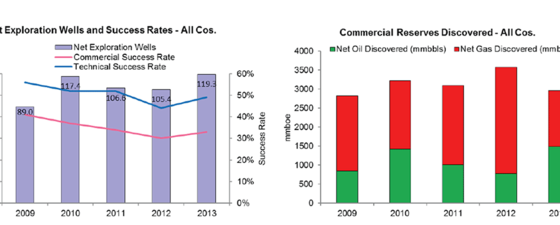One can learn a lot from looking at even the recent past. For that reason, Richmond Energy Partners annually measures the pulse of international conventional exploration outside North America by monitoring the performance of 40 mid- and large-cap E&P companies over the previous five years. From this analysis, published in the company’s yearly Exploration Performance report, the conclusion is that it has been a very successful period for exploration for conventional hydrocarbons, particularly gas, and that 2013 was the best year for oil discoveries for five years. The study also reveals that commercial success rates are being maintained at around one in three globally, with a finding cost of $1 per barrel of oil equivalent over the last five years.
Gas discoveries in East Africa, Israel and Australia make up half of the 35 Bboe discovered by the companies analysed. However, although these discoveries are considered commercial, much of this gas will take decades to produce and monetise. In fact, the study finds 40% of recent discoveries have not yet started development six years after discovery.
 Frontier wells drilling and planned for 2014.A look at the key plays in East Africa and Iraq tells an interesting story for the future, as they appear to be maturing rapidly and delivering smaller discoveries. In addition, the dramatic increase in spending on frontier drilling in recent years has been largely disappointing, with a success rate of less than 10%.
Frontier wells drilling and planned for 2014.A look at the key plays in East Africa and Iraq tells an interesting story for the future, as they appear to be maturing rapidly and delivering smaller discoveries. In addition, the dramatic increase in spending on frontier drilling in recent years has been largely disappointing, with a success rate of less than 10%.
Although the new pre-salt play in Angola has become the key emerging play globally, drilling in ever deeper waters does not always bring rewards, and its high cost, coupled with very little commercial success, can be a company breaker as much as a company maker. At $100m average cost per well, and with $2.9 billion budgeted in 2014 for deepwater frontier wells, 2014 may be literally a make or break year for several exploration companies.
Benching Performance
Every exploration well drilled between 2009 and 2013 by the companies monitored for this report, including Cairn, Anadarko, Afren, Tullow and Lundin, has been recorded and analysed. The study assesses the likelihood of a commercial development for each successful well and estimates the most likely recoverable volumes.
Resource estimates for pre-2013 wells have also been reviewed in the light of recent appraisal or development activity. Each company is assessed on gross and net wells drilled, commercial success rates, discovery sizes, net discovered volumes of oil and gas per well and finding costs.
From this analysis a systematic benchmarking of company exploration performance can be developed, together with an analysis of global trends in conventional exploration and an under- standing of where the industry is focusing geographically and geologically. This type of analysis helps gain an understanding of the reasons for failure of prospects in key plays and of the successful conversion of resources to reserves, plus an appreciation of what drives and leads a successful exploration strategy.
This analysis of the past five years can then be applied to planned wells, and the report includes a look at forward drilling plans for 200 wells in 46 countries, with forecasts of prospective resource volumes and exploration risks.
 Exploration activity and discovered commercial reserves 2009–2013 for all 40 companies.
Exploration activity and discovered commercial reserves 2009–2013 for all 40 companies.





